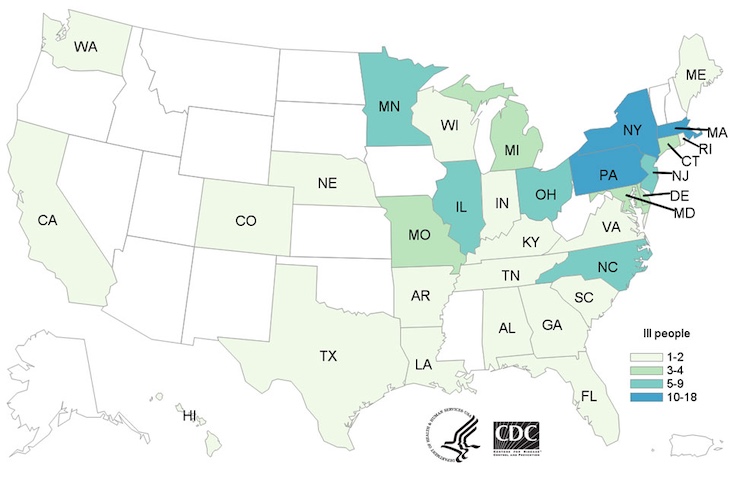The raw chicken Salmonella Infantis outbreak has ended with 129 people sick, according to the Centers for Disease Control and Prevention (CDC). Twenty five people were hospitalized in this outbreak, and one death was reported from New York.

The case count by state in this raw chicken Salmonella outbreak is: Alabama (1), Arkansas (3), California (1), Colorado (1), Connecticut (3), Delaware (3), Florida (2), Georgia (2), Hawaii (1), Illinois (7), Indiana (1), Kentucky (2), Louisiana (2), Maine (1), Maryland (4), Massachusetts (17), Michigan (4), Minnesota (5), Missouri (3), North Carolina (7), Nebraska (1), New Jersey (9), New York (18), Ohio (8), Pennsylvania (13), Rhode Island (2), South Carolina (1), Tennessee (1), Texas (2), Virginia (2), Washington (2), and Wisconsin (1). Illnesses started in January, 2018 and ran through January, 2019. The patient age range was less than 1 year to 105.
Public investigators used the PulseNet system to identify people sickened with the outbreak strain of Salmonella Infantis. Those patients reported eating different types and brands of chicken products purchased from many locations. Investigators found the outbreak strain in raw chicken products, live chickens, and raw chicken pet food. In fact, the outbreak strain was found in 76 slaughter establishments.

You can contact food safety attorney Fred Pritzker for help by calling 1-888-377-8900 or 612-338-0202.
The bacteria in this outbreak was resistant to multiple antibiotics, including ampicillin, ceftriaxone, chloramphenicol, ciprofloxacin, fosfomycin, gentamicin, hygromycin, kanamycin, nalidixic acid, streptomycin, sulfamethoxazole, tetracycline, and trimethoprim-sulfamethoxazole. This pathogen is present in live chickens and many types of raw chicken products. The CDC stated that “It may be widespread in the chicken industry.” The government has “requested” that the chicken industry take steps to reduce Salmonella contamination.
And, as usual, the outbreak notice ends with a cautionary statement about how consumers should handle raw chicken. In other words, assume it’s contaminated. Always wash your hands well after handling raw chicken. Wash countertops, utensils, and kitchen equipment that has come into contact with raw chicken. Cook all chicken to 165°F, as measured with a food thermometer, before serving. And carefully avoid cross-contamination between raw chicken and other foods. Finally, the CDC does not recommend feeding raw diets to pets, since people can become sick through contact with the food and contact with pets.




